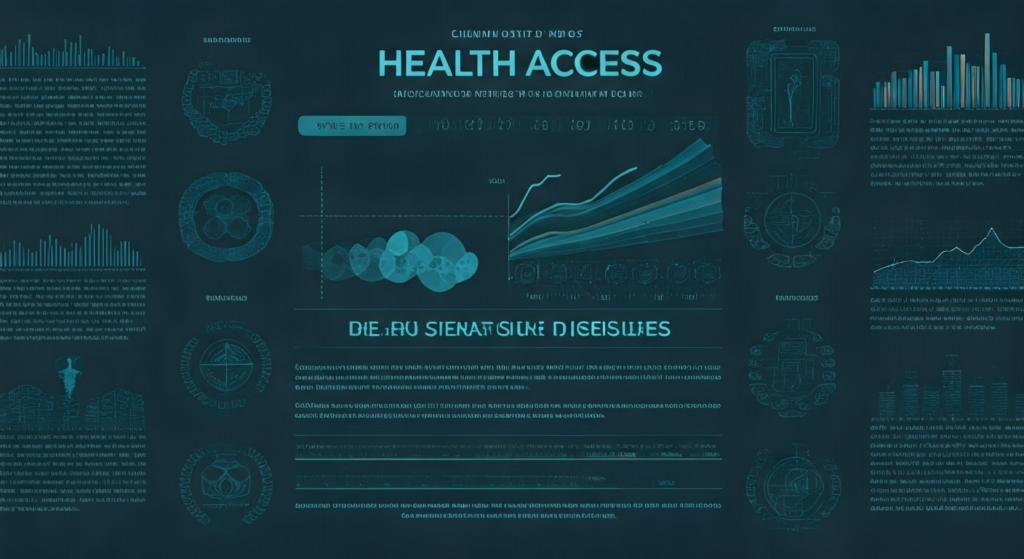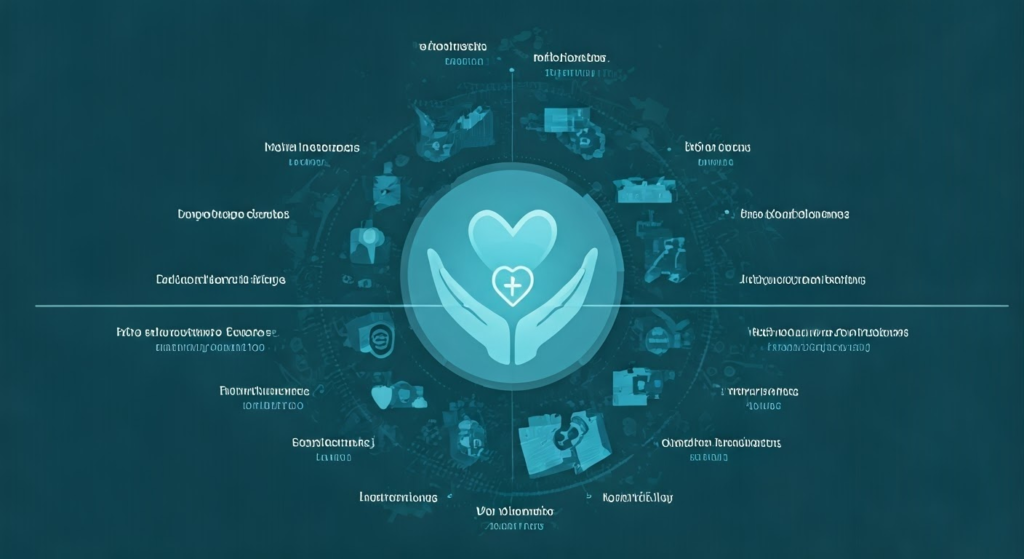
Key Highlights
- Millions of Americans face barriers to accessing healthcare, leading to health disparities.
- Financial constraints, geographic limitations, and inadequate health insurance are major obstacles.
- Strategies such as expanding insurance coverage, increasing health facilities, and using telehealth show promise in bridging these gaps.
- Community initiatives and impactful public policies are crucial to ensure health equity.
- Understanding these factors and taking personal steps can empower individuals toward better healthcare access and improved health outcomes.
Introduction
Health care access is very important for a successful society. It is not just about having insurance coverage. It is also about making sure that healthy people can get a usual source of care and a good primary care provider and health care provider services when they need them, especially considering the impact of poor access on the timely use of personal health services and health outcomes, particularly related to cardiovascular disease. We must understand the factors that affect access to health care to help create a healthier population.
Understanding Health Access in the United States

Navigating the United States healthcare system can be tough. It gets even harder for people who struggle to get important medical care and resources, especially for those with lower incomes. Sadly, health disparities, including ethnic disparities and disparities related to sexual orientation, affect many individuals. These disparities lead to unnecessary suffering and create larger gaps in health outcomes among different groups, as highlighted in the National Institutes of Health disparities report. It’s very important to understand how health access works in the U.S. to tackle these unfair issues.
The Current State of Health Access
The United States has some of the best medical care in the world. However, not everyone can access these services equally. This problem affects many people’s health outcomes. Differences based on wealth, where people live, and race or ethnicity still create issues in the healthcare system.
There has been some progress, like more people getting health insurance coverage. But the costs are still a big problem. High deductibles, copays, and expensive medications often make people delay or skip important health services.
Also, getting care is not just about having insurance. It also involves having nearby healthcare providers, understanding cultural needs, and having convenient hours that fit work and family lives.
Key Factors Influencing Health Access
Socioeconomic status is a key factor that affects how people access health care. Those from lower socioeconomic backgrounds usually have more health care needs. This happens because they often lack preventive care and face more environmental risks. To help them, we need to do more than just offer insurance.
There are also large differences based on ethnicity when it comes to getting care that is timely and of good quality. Many marginalized communities deal with problems such as language barriers, cultural misunderstandings, and a lack of trust in the health care system.
To tackle these issues, we need a plan that fits the unique needs of different ethnic groups. This includes offering care that is sensitive to different cultures, increasing diversity in the health care workforce, and involving communities actively. These steps are important to close gaps and promote health equity.
Barriers to Health Access

Millions of Americans still have a hard time getting the health services they need. This problem impacts not just individuals but also places pressure on the whole healthcare system. It leads to higher costs and health issues that could be prevented.
Finding and solving these problems is important for social fairness. It is essential for building a healthier and better country for everyone.
Financial Constraints
Financial limits and the limited availability of health care resources are a major barrier to health care access in the United States. Even though the Affordable Care Act has helped more people get insurance, millions still do not have it. This is mainly because the cost of insurance and out-of-pocket expenses, as highlighted by the Kaiser Family Foundation, are too high, negatively impacting their overall quality of life. For those living below the federal poverty level, these costs are tough to handle, which often means they have to choose between their health and other basic needs.
High deductibles, rising prices for medicine, and surprise medical bills heighten financial worries. This stress affects many people, even those who have insurance. The worry about huge medical bills can stop individuals from getting preventive care or treatments on time, which can worsen their health issues, including increasing the risk of heart disease, and possibly lead to more expensive treatments later on.
To fix the problem of rising health care costs, we need to work on several solutions. Options include negotiating lower prices for prescriptions, encouraging the use of generic drugs, and making healthcare billing clearer. These steps can help lessen financial strain and make health care more affordable for everyone.
Geographic Limitations
Geographic limits make it hard to get good healthcare, especially for people in rural and underserved communities. In these places, there are often not enough healthcare resources and not many healthcare professionals.
The lack of doctors, specialists, and healthcare facilities leads to longer waiting times for appointments. It also means people have to travel far for specialized care, making it more likely they will skip necessary medical attention.
The problems go beyond just being far away. They include:
- Not having reliable ways to get around
- Limited internet access, which affects telehealth services
- Poor healthcare services administration and infrastructure
To solve these geographic limits, we need a plan that does several things. We should encourage healthcare professionals to work in underserved areas. We need to improve telehealth services. Finally, we should support better public transportation to healthcare facilities.
The Role of Health Insurance
Health insurance coverage is paramount in accessing affordable healthcare services. While the Affordable Care Act has led to a decline in uninsured adults, disparities persist. Lack of insurance or inadequate coverage translates into limited access to preventive screenings, delayed treatment, and an increased likelihood of facing catastrophic medical expenses.
A critical aspect of this issue is the type of coverage.
| Coverage Type | Pros | Cons |
| Private Insurance | Often broader provider networks and shorter wait times. | Can be expensive, with high premiums and deductibles. |
| Public Insurance | Provides safety net for low-income individuals and families. | May have limited provider choices and longer wait times. |
Closing the coverage gap requires a multi-pronged strategy that addresses the unique challenges faced by different segments of the population, including affordability, access to quality insurance plans, and awareness of available resources.
Strategies for Improving Health Access

Improving health access in the United States needs a complex plan. We must deal with the reasons that stop many people from getting the healthcare they need. This goes beyond just having health coverage. It is important to make sure that healthcare is fair, affordable, and respect different cultures.
To find lasting solutions, everyone must work together. This includes leaders in government, healthcare, community groups, and the people themselves. By joining forces, we can create a future where all individuals can reach their best health.
Enhancing Health Insurance Coverage
A key step in improving access to health services is to fix the ongoing gaps in health insurance status and health status. The Affordable Care Act helped many get coverage through the program of the insurance marketplace, but millions still do not have insurance or have limited coverage. It is important to present private health insurance as more affordable and to make the enrollment process simpler with the most recent data. Strengthening public programs like Medicare and Medicaid can also help provide safety for those in need.
Expanding coverage is very important. However, it is just as important to make sure that this coverage leads to real access to quality care. We need to focus on offering complete benefits. This includes mental health services, dental care, and drug coverage, which often don’t get enough attention. It’s key to address the high out-of-pocket costs for these services. This will help protect people financially and avoid medical debt.
Moreover, to improve national healthcare quality, we need to promote value-based care. This means we should focus on patient outcomes instead of how many services are provided. This change can result in better care coordination, fewer hospital readmissions, and better health outcomes for everyone, no matter what insurance they have.
Expanding Healthcare Facilities
It is very important to fix the unfair spread of health care facilities, especially in rural and city areas with few services. To give people better access to quality medical care, we need to invest in building new hospitals, clinics, and community health centers in places where they are truly needed. The focus should be on not just building new places but also hiring and keeping a diverse health care team so everyone can get care that understands their culture and languages.
Also, we must improve the health care resources and health statistics in these under-served areas. This means making sure there’s access to special medical equipment, diagnostic tools, and various experts who can manage complex health needs in the community. By enhancing what local health systems can do, we can raise the quality of care and cut down the long trips people have to make for specialized treatment.
In addition, providing enough health resources for community health programs, mobile health clinics, and telehealth can help connect with people in far or hard-to-reach places. This overall plan can effectively deliver needed health services, boost preventive care, and fix health issues caused by location problems.
Increasing Health Literacy
Health literacy is very important. It helps people understand the healthcare system better. This means knowing medical information and having the skills to make smart decisions about their health. It’s essential to create health education programs that fit different skill levels and cultures. This way, we can help people manage their health better.
For patients to feel empowered, clear communication from healthcare providers is needed. It is important to simplify complicated medical terms. Using pictures and encouraging patients to ask questions can help them understand better. This builds trust, makes patients happier, and helps them stick to treatment plans.
Also, putting health information in community places, like schools, workplaces, and churches can help reach more people. When we build a culture that values health literacy, we empower individuals to take charge of their health. This can lead to better health outcomes and lower health disparities.
Technology’s Role in Enhancing Health Access
In a time when technology is advancing quickly, using new ideas is key to closing the healthcare access gap. Telehealth platforms, mobile health apps, and electronic health records can greatly improve access to care, raise the quality of services, and help people manage their health better.
By using technology in healthcare, we can break down barriers caused by distance. This will give patients easy access to health information and services. It will help us work toward a fairer and more patient-focused healthcare system.
Telehealth and Remote Healthcare Services
Telehealth has changed the way we access health care. It helps people in remote places or those who have trouble getting healthcare. With video calls and remote monitoring, patients can talk to doctors, specialists, and mental health experts without traveling far. This is especially helpful for those with chronic conditions who have many follow-up appointments. It cuts down on travel needs and helps keep money in people’s pockets.
To make telehealth services better, we need to close the digital gap. This means making sure people have good internet and the right devices, especially in low-income and rural areas. Also, lawmakers should create payment rules that encourage doctors to use telehealth, making it a way for them to earn a living.
Growing remote health care services is not just about making life easier. It helps patients receive continued care, take charge of their health, and stay in touch with medical providers. As technology gets better, telehealth will keep expanding, making quality healthcare easier for everyone to access.
Mobile Health Apps and Patient Empowerment
The growth of mobile health apps offers a great chance for people to take control of their health. These apps help users track fitness, remind them about medications, give custom health info, and link them to healthcare providers. For those in underserved communities or with less access to traditional healthcare, mobile health apps can be a vital connection to support, resources, and important health information.
To make sure everyone can benefit from mobile health technology, we need to work on digital literacy and ensure affordable internet and mobile devices are easy to find. We also have to deal with privacy and data security issues. The health info stored and shared through these apps must be protected with strong security measures.
By using mobile health apps the right way and including everyone, we can help people become more active in their own healthcare. This can lead to better health literacy and improved health outcomes.
Community Initiatives and Public Policies
To make lasting improvements in health access, we need to work together. This means going beyond just the usual healthcare places. Engaging with communities and creating good public policies is very important. It helps to tackle the social determinants of health. This will ensure that everyone has equal access to health services.
Helping communities create and carry out plan tailored to their needs can greatly help. It can solve special issues and build trust, especially among the people who need extra support. When we work together, we can promote health equity and build a healthier future for everyone.
Grassroots Efforts to Improve Local Health Access
Community initiatives and grassroots efforts are key to improving healthcare access in local areas. These projects come from a good understanding of the unique problems and strengths within a community. They allow for focused help and solutions that respect cultural needs. Community health workers, local groups, and faith-based organizations are important in linking people to resources, offering health education, and pushing for policy changes that support health equity.
Grassroots movements often use social networks, trusted leaders, and relevant communication methods to effectively reach people who are underserved. They can design programs that meet specific needs, like helping with transport to doctor visits or creating community gardens to encourage healthy eating habits.
When communities take an active role in improving their health, these grassroots efforts help individuals, build social bonds, and create a sense of responsibility for local health outcomes. This approach works to reduce health disparities and helps build healthier communities from the ground up.
Impact of Recent Health Policies
Public policies play a big role in shaping healthcare access. The Affordable Care Act is a good example. It made major changes, allowing millions more people to have insurance. It also included rules to protect people from discrimination because of pre-existing conditions. These changes made it easier for many Americans to access care and showed how important it is to create fair health policies.
Recently, health policies have not just focused on insurance coverage. They have also looked at care that offers value, the social factors that affect health, and new ways to deliver care, such as telehealth, which can contribute to lowering overall health care costs. These changes show that improving health access is complex. We need to tackle problems that go beyond what we usually think about in healthcare.
To keep improving, we need to closely check and update current health policies. This will help tackle new challenges and fit with the changing healthcare needs. Ongoing reviews, making decisions based on data, and working to reduce health disparities should be key parts of future policies.
Conclusion
Improving health access is very important for a healthier society. By knowing the current situation, key factors, and barriers to health access, we can work to improve health insurance coverage, expand healthcare facilities, and boost health literacy. Technology is a big help through telehealth services and mobile health apps. Community programs and public policies also play a role in improving local health access. To improve your health access, focus on being informed, supporting better policies, and using available resources. By taking positive steps and dealing with key factors affecting health access, we can work together for a healthier future for everyone.
Steps to improve your own health access
Navigating the healthcare system can be hard. But taking steps to improve your health access can really help your overall health. Start by knowing your health insurance coverage. This means understanding your network, covered benefits, and out-of-pocket costs. If there’s anything confusing, ask your insurance provider or a healthcare worker for help.
It is very important to build a good relationship with your primary care physician. Regular checkups and talking openly about your health can help spot potential issues early on. Also, look into community resources like health centers or free clinics for support and affordable care. Being proactive and informed is key to getting the most out of your healthcare access.
Key factors that impact health access
Health access is affected by many factors, not just health insurance. While having affordable insurance is important, we also need to look at other issues. These issues include how close care is, if it respects different cultures, and how people can get to appointments.
Problems based on money, race, ethnicity, and where someone lives still make it hard for many to get good healthcare. We need to focus on fixing these problems and make sure everyone has equal chances to be healthy. By learning about these factors and supporting the right policies, we can work towards a fairer healthcare system for everyone.
What Are the Main Barriers to Health Access in the U.S.?
Financial challenges, like lack of health insurance or not enough coverage, can be a big problem. There are also geographic barriers, especially in rural areas where there are few healthcare facilities and providers. These barriers help create health disparities.
How can improving health access contribute to overall well-being?
Improving access to health services helps people get the care they need when they need it. This includes preventive care and managing chronic conditions. By acting quickly, we can lead to better health outcomes. It also reduces the risk of poor health outcomes and improves overall well-being.
https://doi.org/10.1377/hlthaff.2010.0026
https://data.hrsa.gov/tools/shortage-area/mua-find
https://data.hrsa.gov/topics/health-workforce/ahrf
https://www.youtube.com/user/ClintonHealth
https://www.hopeinitiative.org/indicator/access-to-primary-care

